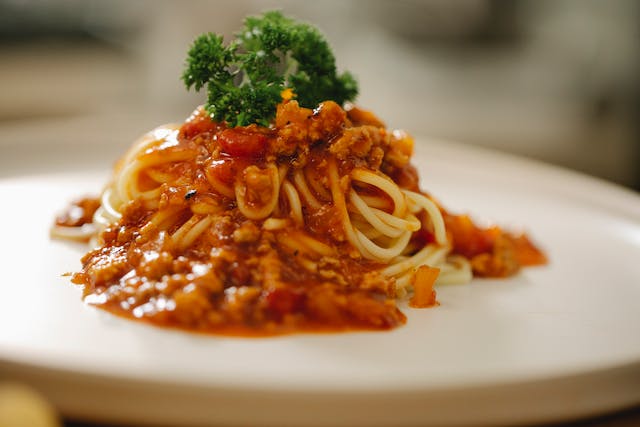Introduction: Meet Lucy Rodriguez, the culinary wizard behind Spicy Arrabbiata Delight. With over a decade of experience in crafting tantalizing pasta sauces, Lucy has become a trusted source of culinary knowledge. In this article, she unravels the secrets of pasta sauce preservation, offering you advanced techniques to extend the shelf life of your favorite sauces.
Introduction:
Meet Lucy Rodriguez, the culinary wizard behind Spicy Arrabbiata Delight. With over a decade of experience in crafting tantalizing pasta sauces, Lucy has become a trusted source of culinary knowledge. In this article, she unravels the secrets of pasta sauce preservation, offering you advanced techniques to extend the shelf life of your favorite sauces. Whether you’re an amateur home cook or an avid sauce enthusiast, you’re in for a treat! Pasta sauce preservation is a culinary skill that every enthusiast should master. Many of us have experienced the frustration of discovering a jar of beloved sauce, only to find it spoiled and unsuitable for consumption. This is where the art of pasta sauce preservation comes into play. A well-preserved sauce can last for weeks, if not months, in the fridge, ensuring that you have a quick and delicious meal option at your fingertips. The primary reason for preserving pasta sauce is to maintain its flavor consistency. When you put time and effort into creating a delectable sauce, you want it to taste just as fantastic every time you use it. Additionally, pasta sauces often contain ingredients like garlic, herbs, and spices that can spoil if not stored correctly. Therefore, understanding how to properly preserve your sauce is essential.

Photo by Angele J: https://www.pexels.com/photo/cooked-pasta-with-sliced-tomatoes-and-green-leafy-128408/
Right Container
When it comes to glass jars, they are a popular choice due to their airtight and non-reactive properties. However, they are heavy and can break easily, making them less convenient for some. On the other hand, airtight plastic containers are lightweight and unbreakable, but they may absorb odors and stains over time. Vacuum-sealed bags are space-efficient and minimize air exposure, but they are not reusable and may require special equipment. The choice of container ultimately depends on your preferences and storage conditions. However, whichever container you choose, ensure it is thoroughly cleaned and sanitized before use to prevent any contamination.
| Container Type | Pros | Cons |
|---|---|---|
| Glass Jars | Airtight and non-reactive | Heavy and breakable |
| Airtight Plastic | Lightweight and unbreakable | May absorb odors and stains. |
| Vacuum-Sealed Bags | Space-efficient and minimizes air exposure | Not reusable and may require special equipment. |
Maximizing Flavor and Freshness
Cool Sauce Properly: After cooking your sauce, allow it to cool to room temperature before transferring it to the chosen container. Hot sauce in a sealed container can create condensation, which may lead to spoilage.
Minimize Air Exposure: Air is the enemy of freshness. Ensure that your container is airtight to prevent air from seeping in and affecting the sauce’s taste and quality.
Label and Date: It’s easy to forget how long your sauce has been in the fridge. Label the container with the date of preparation to help you keep track of its freshness.
Avoid Overfilling: Leave some space at the top of the container to accommodate any expansion when the sauce freezes. Overfilled containers may burst, causing a mess in your freezer.
Safe Handling Practices
Clean Hands and Utensils: Always use clean hands and utensils when handling sauce. This prevents the introduction of bacteria that can cause spoilage.
**Refrigeration: **Store your pasta sauce in the refrigerator within two hours of preparation. Avoid leaving it out at room temperature for extended periods.
Thawing: When you’re ready to use your preserved sauce, thaw it in the refrigerator rather than on the countertop. Slow, controlled thawing minimizes the risk of spoilage.
Smell and Visual Checks: Before using the sauce, give it a good sniff. If it smells off or has visible mold, it’s best to discard it.

Photo by Klaus Nielsen: https://www.pexels.com/photo/appetizing-pasta-bolognese-served-with-parsley-6287525/
Testing Sauce Viability
The Sniff Test: Your nose is your best ally when it comes to detecting spoiled sauce. If it smells sour, off, or has a strange odor, it’s time to part ways with your sauce.
Visual Inspection: Check the sauce for any mold, off-putting discoloration, or unusual texture. If you see any of these signs, it’s better to discard the sauce.
Taste It: While tasting your sauce is a reliable way to assess its freshness, it’s essential to do so with caution. If it tastes unusual, it’s better not to risk consuming it.
Check the Date: If you’ve labeled the container with the preparation date, it’s a quick way to determine if the sauce is still within its recommended freshness period.
Conclusion:
In conclusion, this article has shed light on pasta sauce preservation techniques that go beyond the basics. Whether you’re an occasional cook or a dedicated sauce aficionado, mastering these advanced techniques will elevate your culinary skills and make your pasta nights a delight. As you explore the world of pasta sauce preservation with Lucy Rodriguez, you’ll not only learn how to extend the fridge lifespan of your sauces but also uncover the magic of keeping those delightful flavors alive. Embrace these tips and get ready to savor your favorite pasta sauces for longer, thanks to the wisdom of Spicy Arrabbiata Delight. Pasta sauce preservation isn’t just a practical skill; it’s a way to ensure that your meals are consistently flavorful and enjoyable.

















Leave a Comment
Your email address will not be published. Required fields are marked with *